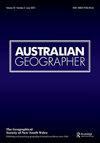Obnoxious Plants and Pestiferous Growths: how figurative language reinforces the management of weeds in Victoria, Australia
IF 2
2区 社会学
Q2 GEOGRAPHY
引用次数: 0
Abstract
ABSTRACT The militaristic metaphors common in public discourses about invasive species have been criticised for promoting combative management approaches and constraining policy responses. But are they really to blame for entrenching a command-and-control approach to managing weeds in Australia? Since 2000, almost every state and territory has introduced new biosecurity legislation encouraging ‘shared responsibility’. Yet, this term remains noticeably absent from new legislation in Victoria. We aim to examine whether public discourses around invasive plants have remained unchanged to better understand how invasive plants have been framed and whether this can provide insight into the lack of engagement with ‘shared responsibility’ in Victorian legislation. This study investigates figurative language used in Victorian newspapers from 1885 to 2020 to describe three invasive plants and their management: Bathurst burr, blackberry and gorse. The figurative language reveals limited acknowledgement of humans' role in the spread of weeds and emphasis on the diverse impacts of weeds on humans. Militaristic metaphors have existed for over 130 years, but are neither the most predominant nor community-mobilising. Overall, figurative language has focused on individual efforts to control weeds, without critical analysis of the inter-relationships between humans and weeds nor having created opportunities for caring or collaborative weed management.令人讨厌的植物和瘟疫的生长:如何比喻语言加强管理杂草在维多利亚州,澳大利亚
关于入侵物种的公共话语中常见的军国主义隐喻因促进好斗的管理方法和限制政策反应而受到批评。但是,他们真的应该为在澳大利亚实行命令和控制的方式来管理杂草而受到指责吗?自2000年以来,几乎每个州和地区都引入了新的生物安全立法,鼓励“共同承担责任”。然而,这个术语在维多利亚州的新立法中仍然明显缺席。我们的目标是研究围绕入侵植物的公共话语是否保持不变,以更好地理解入侵植物是如何被构建的,以及这是否可以洞察维多利亚立法中缺乏“共同责任”的参与。这项研究调查了1885年至2020年维多利亚时代报纸上使用的比喻语言,用来描述三种入侵植物及其管理:巴瑟斯特毛刺,黑莓和金雀花。这种比喻的语言揭示了对人类在杂草传播中的作用的有限认识,并强调了杂草对人类的不同影响。军国主义的隐喻已经存在了130多年,但既不是最主要的,也不是最能动员社区的。总的来说,比喻性语言集中在个人控制杂草的努力上,没有对人与杂草之间的相互关系进行批判性分析,也没有为关怀或合作杂草管理创造机会。
本文章由计算机程序翻译,如有差异,请以英文原文为准。
求助全文
约1分钟内获得全文
求助全文
来源期刊

Australian Geographer
GEOGRAPHY-
CiteScore
4.10
自引率
8.30%
发文量
33
期刊介绍:
Australian Geographer was founded in 1928 and is the nation"s oldest geographical journal. It is a high standard, refereed general geography journal covering all aspects of the discipline, both human and physical. While papers concerning any aspect of geography are considered for publication, the journal focuses primarily on two areas of research: •Australia and its world region, including developments, issues and policies in Australia, the western Pacific, the Indian Ocean, Asia and Antarctica. •Environmental studies, particularly the biophysical environment and human interaction with it.
 求助内容:
求助内容: 应助结果提醒方式:
应助结果提醒方式:


